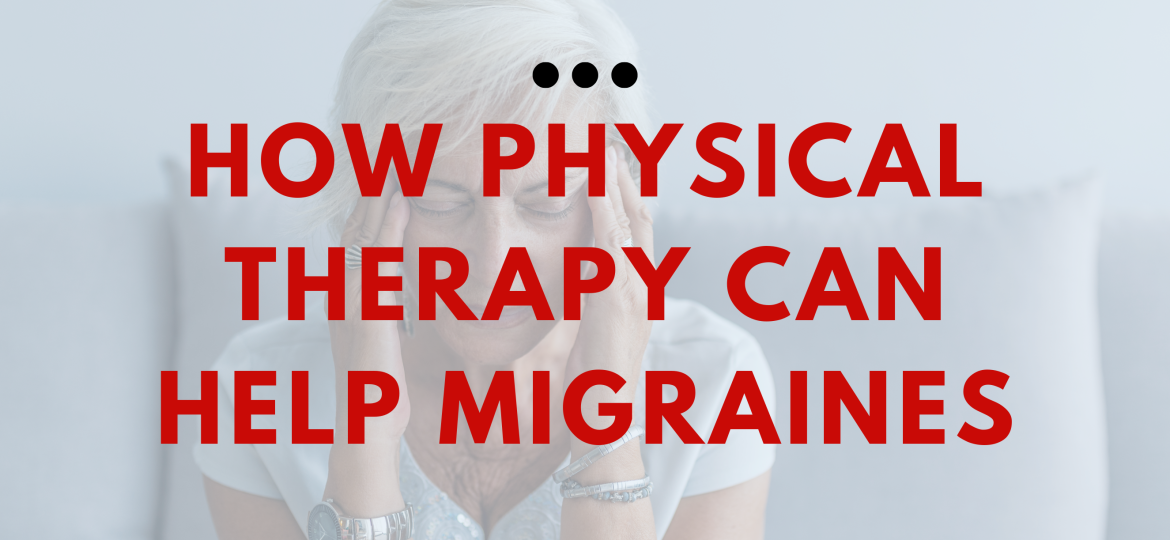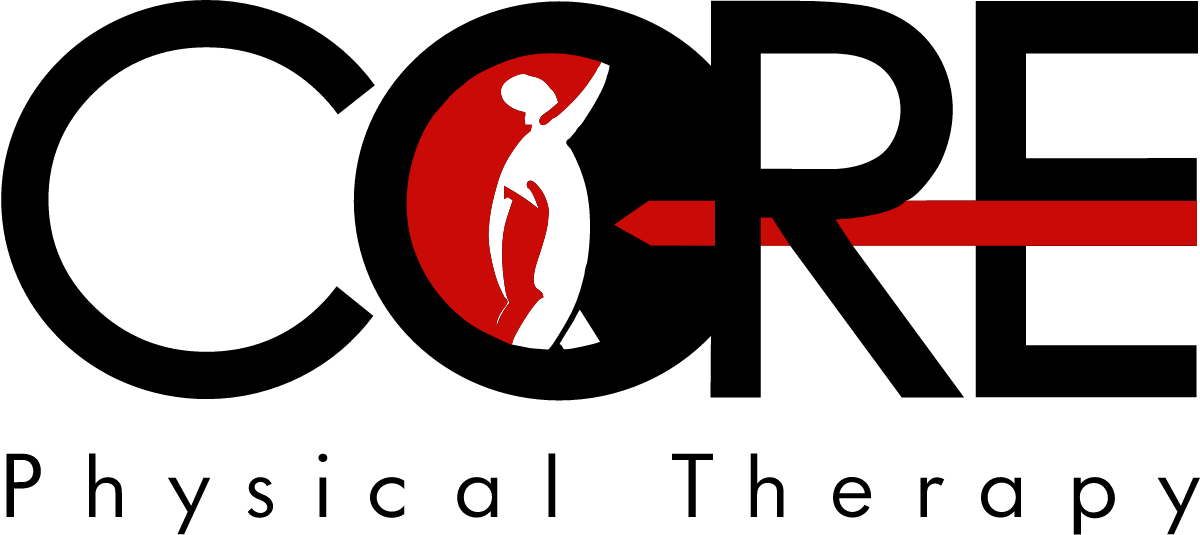
This blog post was written by Kirsten Radke, a Core Physical Therapy PT who specializes in vestibular therapy.
We get dozens of patients a month suffering from headaches and migraines. As part of National Migraine Awareness Month we wrote this post to dig into how physical therapy can help those suffering from migraines. First, let’s clarify headaches versus migraines.
What is a Headache?
A headache is pain or discomfort in your head or face. There are a variety of types of headaches with the most common types making up >98% of all headaches:
- Tension Headaches: A dull, aching pain all over your head. Often linked to muscle tightness in your shoulders, neck, and scalp.
- Cluster Headaches: Severe pain on one side of the head, occurring in groups or clusters.
- Sinus Headaches: Pain around your forehead, eyes, and cheeks, usually due to sinus issues.
- Rebound Headaches: Caused by overusing pain medications.
What is a Migraine?
Migraines are a genetically influenced specific type of headache with distinct features:
- Pain: Throbbing or pulsing, often on one side of your head.
- Severity: Moderate to severe pain that can stop you from doing daily activities.
- Duration: Can last from 4 to 72 hours if untreated.
- Symptoms: Often includes nausea, vomiting, and sensitivity to light and sound.
- Aura: Some people experience visual disturbances, tingling, or other neurological symptoms before the migraine starts.
The World Health Organization ranks migraine as the second leading cause of years lived with disability and the leading cause of disability in women aged 15–49 years.
There are different types of migraines including:
- Migraine without Aura
- Migraine with Aura (Classic Migraine)
- Chronic Migraine
- Hemiplegic Migraine
- Retinal Migraine (Ocular Migraine)
- Menstrual Migraine
- Vestibular Migraine
- Abdominal Migraine
- Status Migrainosu
Why Do We Get Migraines?
Migraines are a complex neurological condition influenced by a variety of factors, including genetics, environmental triggers, and lifestyle.
These are the most common reasons we experience migraines:
1. Genetics
- Family History: Migraines often run in families. If one or both of your parents have migraines, you are more likely to experience them as well.
- Genetic Factors: Specific genes are associated with an increased risk of migraines.
- Hereditary Patterns: Research suggests that about 70% of people with migraines have a close relative who also suffers from them, indicating a strong genetic component.
2. Hormonal Changes
- Gender Differences: Migraines are more common in women than in men, partly due to hormonal fluctuations. Estrogen levels, in particular, play a significant role.
- Menstrual Cycle: Many women experience migraines in connection with their menstrual cycle, often occurring just before or during menstruation.
- Pregnancy and Menopause: Hormonal changes during pregnancy and menopause can influence migraine frequency and severity.
3. Environmental Triggers
- Stress: Emotional stress and anxiety can trigger migraines.
- Sleep Patterns: Both lack of sleep and oversleeping can provoke migraine attacks.
- Diet: Certain foods and beverages, such as aged cheeses, processed meats, alcohol (especially red wine), and caffeine, can trigger migraines.
- Sensory Stimuli: Bright lights, loud noises, and strong smells can set off a migraine.
4. Physical Factors
- Changes in Routine: Disruptions in daily routines, such as travel, changes in work shifts, or alterations in eating and sleeping patterns, can trigger migraines.
- Physical Exertion: Intense physical activity or exertion can provoke migraines in some people.
5. Chemical Imbalances
- Neurotransmitters: Imbalances in brain chemicals, including serotonin, play a crucial role in migraines. Changes in serotonin levels can affect the regulation of pain in the brain.
- Inflammatory Substances: During a migraine, certain chemicals are released that cause blood vessels in the brain to swell and press on nearby nerves.
6. Other Factors
- Weather Changes: Fluctuations in weather, such as changes in barometric pressure, can trigger migraines.
- Medications: Some medications can induce migraines as a side effect, including certain types of birth control and vasodilators.
- Dehydration: Not drinking enough fluids can lead to dehydration, which is a common migraine trigger.
Migraines and Genetics
- Gene Mutations: Mutations in the CACNA1A, ATP1A2, and SCN1A genes are linked to familial hemiplegic migraine, a rare subtype of migraine with aura.
- Polygenic Nature: Most migraines are polygenic, meaning they result from the combined effects of multiple genes.
- Genome-Wide Association Studies: These studies have identified over 40 genetic loci associated with migraine susceptibility, highlighting the complex genetic basis of the disorder.
“If you need PT, GO HERE!!! CORE Physical Therapy is AMAZING! I have seen Dr. Ellen Majewski for several different issues and have experienced complete healing. She has even helped significantly with my migraines! I have also seen a few of the other therapists at the clinic and have nothing but great things to say about all of them. I recommend CORE to everyone I know that could use a physical therapist, especially since they use manual manipulation techniques on you for 40-45 minutes rather than throwing you on exercise equipment and periodically checking in. I can’t say enough great things about them!” – Andrea
How can physical therapy help
Physical therapy plays a pivotal role in helping patients understand their diagnosis, learn lifestyle management techniques, and experience symptom reduction from headaches and migraines.
No one migraine or headache patient is the same. A “migraine” or “headache” is merely a diagnosis; our physical therapists partner with patients on their individual healing journey. This begins with understanding your unique and in depth medical history, timing and triggers of episodes, goals, and addressing how your symptoms impact your daily life.
Core Physical Therapy takes a holistic approach to migraine and headache management by utilizing our osteopathic manual therapy skills of craniosacral therapy and myofascial release to address tension, restrictions, and impairments throughout the entire body. In addition, we have Clinically Certified Vestibular Therapists who have advanced training and experience in supporting patients who suffer from vestibular migraines, hemiplegic migraines, and ocular migraines.
Moreover, our physical therapists recognize the importance of a collaborative approach. We consider ourselves a part of your healthcare team and understand that we are a working part of your larger healing circle. This includes communicating with your primary doctor(s), specialists, and your other interdisciplinary providers.
Navigating chronic and recurrent episodes of headaches and/or migraines is exhausting and mentally and emotionally taxing. Core believes that you deserve to feel heard and supported. Our therapists and network of interdisciplinary providers are prepared to partner with you on your healing journey.
“After my husband experienced relief for his back at Core Physical Therapy, I knew where I should go when my physician suggested physical therapy for my migraines and shoulder and neck pain. My husband had been sharing how pleased he was with his therapist, Alex Spencer, PT, DPT. My appointment was with Laura Palmer, PT, DPT. She has to be second to none. Her biography tells of classes she has taken in addition to her degrees. As I write this, she is preparing for additional classes. I have felt much better after starting with Laura. What I really enjoy is her ability to be personable while maintaining her professionalism. I have not given many “A+”s in my 43 years in the classroom, but I think I would have to give one to Laura and Core Physical Therapy.” – Barbara B
WHAT PTS DO TO HELP PATIENTS WITH MIGRAINES
Physical therapists at Core Physical Therapy can help manage migraines through a holistic approach that includes:
- Manual therapy techniques like craniosacral therapy and myofascial release to address tension and restrictions in the body.
- Exercises and stretches to improve posture and mobility.
- Collaboration with your doctor and other healthcare providers to develop a comprehensive treatment plan.
If you’re looking for a physical therapy clinic that is ready to get to the core of your migraines, reach out to book your first appointment. Want to make sure Core Physical Therapy is the right fit? Consider a short discovery call with one of our physical therapists.
